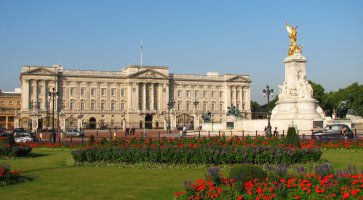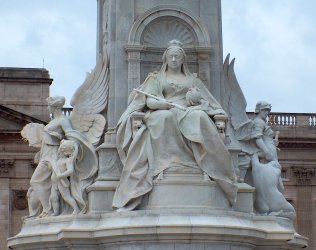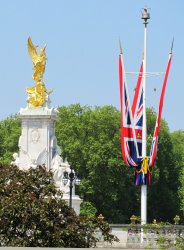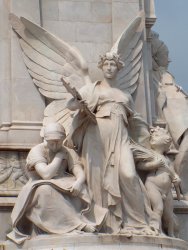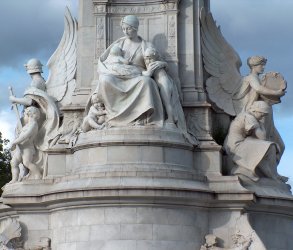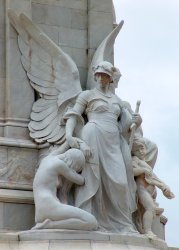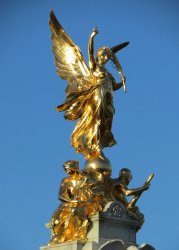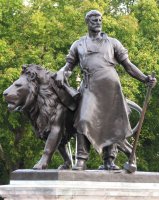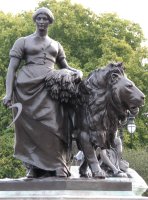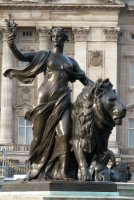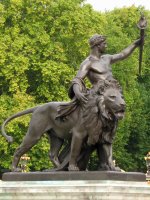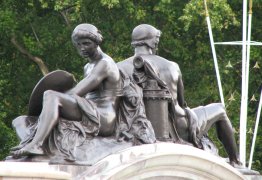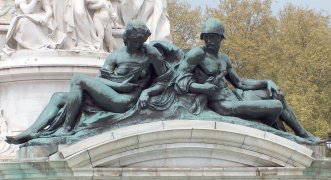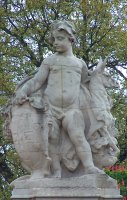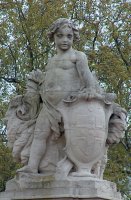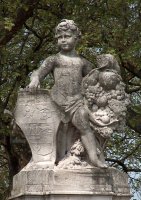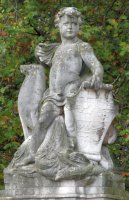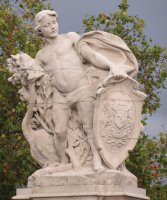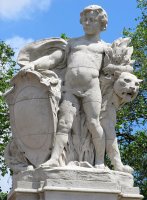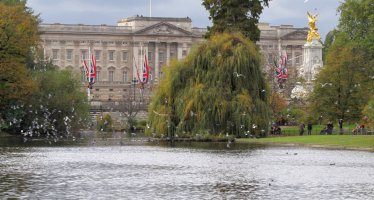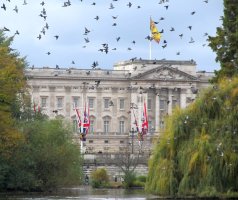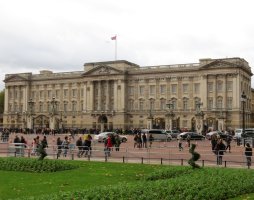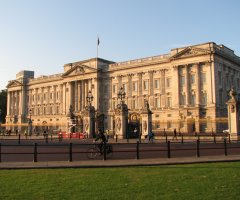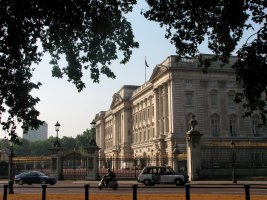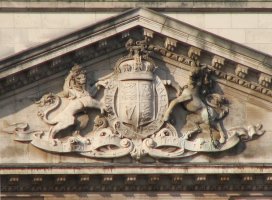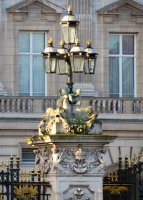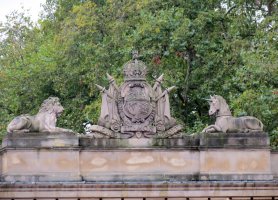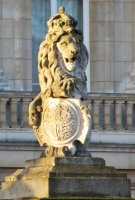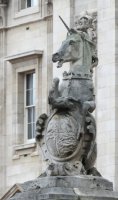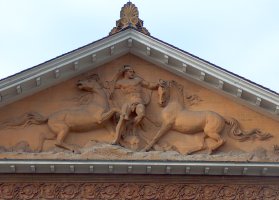The Victoria Memorial, in front of Buckingham Palace
View of Victoria Memorial and Buckingham Palace.
The Victoria Memorial stands in front of Buckingham Palace, to the south side of Green Park, at the other end of the Mall from Trafalgar Square. The sculptor was Sir Thomas Brock.
The Victoria Memorial dates from a generation after the Albert Memorial, and what a contrast: the earlier monument is a High Victorian Gothic jewel with contributions by many sculptors, while the later is Classical Edwardian, and if we exclude the outer ring of pillars with cherubs, the statues represent entirely the work of one sculptor, Thomas Brock, taking him a decade to complete. It is pictured above - click on any picture to enlarge, or hover for caption.
The scheme belongs to the architect Aston Webb, who won the competition to design the setting for Brock's monument in 1902: it would be 1911 before the edifice was finally unveiled, and even then the bronze groups with lions were not yet in place.
Queen Victoria.
The enormous statue of Queen Victoria, over 18 ft high, and made in Carrara marble (the bulk of the memorial is recorded as being made from Pentelic marble), is seated against a great pediment, facing away from Buckingham Palace and down the Mall towards Trafalgar Square. This truly monumental Victoria wears an enveloping robe and carries orb and sceptre. Around the curved sides of the pedestal, and slightly lower than the monarch, are an angel of Truth to her right (the viewer's left), and an angel of Justice to her left (our right). Truth carries a mirror, is crushing a snake under her foot, and is accompanied by a seated woman seeking the truth in a manuscript, and a cherub bearing some frond of palm leaves. Justice, a suitably more severe armoured figure with helmet and sword, is helping a weeping nude woman at her feet, and also has an accompanying cherub, who bears Justice's scales. (For other allegorical figures, see here for Truth and here for Justice.) To the rear, facing the Palace, is a group of Motherhood, sometimes called Charity, as a seated figure in repose with three infants.
Truth, Motherhood, and Justice.
Atop the pediment is a winged Victory (other examples of allegorical figures of Victory on this page), very beautiful, with figures of Courage and Constancy crouched at her feet, all gilt. Victory balances on an orb, one hand raised and beckoning, the other holding a long palm frond. Her clingy light drapes, gathered under the breasts with a wide belt, blow in the wind in a manner rather reminiscent of the nereids in the British Museum. Courage wears a helmet and bears a club, while Constancy holds a ship s compass, and both have cloaks swirling out in the breeze. To front and rear we may note stone eagles with outspread wings, symbols of Dominion, or empire. All these together then, show the qualities of the Queen.
Victory, Courage and Constancy.
Evoking the sea empire, the base of the broad plinth on which the central pillar sits forms a quatrefoil with ships' prows in stone (for more examples of ships and ships' prows in sculpture, see this page), and further out there are other nautical devices, and of course the fountains and water themselves.
Manufacture, Agriculture, Peace and Progress.
Next the bronze groups. Four massive lions, each with a monumental figure, stand to the four sides of the monument, the gift of New Zealand. They are Agriculture and Manufacture, Peace and Progress, something of a change from Brock's earlier idea, which was to have winged lions. And there are two pairs of reclining figures to the sides, Art and Science, and Naval and Military Power, lying atop the enclosing walls of the podium, and beneath them, bronze panels of tritons and mermaids. Further low reliefs in stone run along these walls, with tritons, nereids and cherubs desporting in the water with dolphins, water horses and hippogriffs, very delicate, in an Edwardian interpretation of a Roman rather than a Greek style. (Other statues of lions are on this page, and of Mermaids on this page.)
But back to the bronzes. Agriculture and Manufacture are naturalistic, turn of the century figures. Agriculture is a woman, wearing some sort of a milkmaid s costume, and carrying a huge sheaf of corn and a small sickle. Manufacture is a tough workman, muscular, bearded and heavily muscled, wearing an apron and holding a mallet and some rolled up scroll. Peace and Progress bring us back to the classical ideal, Greek rather than Roman again. Peace recalls the summit Victory, with her light garment outlining her form, and a heavier cloak with a bold sweep over the arm and across the legs as she strides forward. In her hand, a sprig of olive leaves. Progress, a young Greek athlete, strides forward holding a torch aloft. All four figures are excellent, appearing monumental even beyond their size, and the lions, carefully modelled after live ones at London Zoo, are suitably fierce.
Art and Science.
The Art and Science group, on the side of the monument towards the park, and Naval and Military Power, on the other side, are almost nude heroic figures, male and female. Their faces are Victorian, the reclining poses, suggestive of controlled power at rest, owe much to the Parthenon pedimental figures. Art has her palette and rests on the top of a Greek pillar, Science holds callipers and some plan, and the two figures face away from each other. By contrast, and appropriately, Naval and Military Power look more in a similar direction. Military Power is a helmeted man with a sword, while Naval Power is a serious-faced woman with a light, decorative headpiece, and cradling a small ship.
Military and Naval Power.
Lastly, we must mention the three gates the Australia Gate, Canada Gate, and South and West Africa Gate, each with two gateposts bearing allegorical figures of the cherubic genre, or more properly, as they are wingless, Amorini. Each figure has a shield, and some animal and items representative of the particular Imperial dominion (as they were in Victoria s time), with an emphasis on the abundance and richness of the produce. Thus the Australia gate has the figure on the one side with a sheaf of corn tucked under his shield, and accompanied by a merino sheep, and the second gatepost figure has a kangaroo and a grapevine - an early tribute to the nascent Australian wine industry.
Allegorical groups from the Australia and Canada Gates.
The Canada gateposts flank the gates to Green Park, behind and to the left of which is a more modern memorial to Canadians in WW2. One figure holds a large cornucopia, or horn filled with fruits, emblematic of abundance, with a small cornsheaf underneath. Representing the more northerly parts of Canada, on the left as we look at the gate from the central memorial, the other figure stands over a net bulging with fishes, and also standing on the net is a large seal. (For those with an interest in Canada, Canada House and the Canadian National Railways Building with its sculpture are noted on the Cockspur Street page.)
Flanking the third gate, the South Africa figure holds as well as his shield, a large branch bearing luscious fruit, and crouched down under it, with neck stretched out and turned enquiringly towards and in front of the figure, is an ostrich. Worn and crumbling as the sculpture is, the pose of that neck remains perfect. West Africa stands over a planted crop of some long-leaved plant, and holds a bunch of it bundled in one arm it is seemingly sweetcorn, or perhaps cassava. The elbow of that arm almost rests on the top of a snarling big cat; a lioness, or more likely a cheetah or leopard. The sculptors were Alfred Drury, and Derwent Wood; the signatures can still be discerned on the bases of some of the statues. Alas, all of these gatepost groups are becoming worn, for they are prominent and unprotected, and made of Portland limestone. What a contrast with the similar-looking pots on the posts along the front of Buckingham Palace, made of imperishable Coade Stone.
Allegorical groups from the South & West Africa Gate.
According to Aston Webb s design, the nautical aspect is maintained along the Mall, and right at the end, Admiralty Arch bears two further stone figures by Brock, Navigation and Gunnery, with other statues along the way - see the separate page.
There is a page on this site devoted to the smaller but still ambitious Queen Victoria Memorial, Liverpool. The Manchester Queen Victoria is noted on this page.
One of the Nereid friezes.
Buckingham Palace
Buckingham Palace from St James's Park.
It is worth saying at least a very few words about Buckingham Palace itself. It started as the town residence of the Duke of Buckingham at the very beginning of the 18th Century, and after passing into Royal hands in the middle of the century, only became the official residence of the reigning monarch with Queen Victoria. Enlargement and remodelling followed, first by John Nash, then Edward Blore, but what we see today from the front is largely Edwardian, being the refaced Portland Stone frontage by Aston Webb, architect of the Victoria Memorial, and completed as late as 1913. From the perspective of these pages, with their focus on sculpture, we have to feel a twinge of regret - early 19th Century pictures show a variety of statues on the pediments, augmented by further allegorical figures by the middle of the century when the front (East) block was added; the public face of the building now has no such figural work (the rear or West facing block which we cannot see retains various friezes). However, we must of course acknowledge the grandeur of the present frontage, and it is a strength of the building that it retains this from whatever angle and in whatever light it is seen, as indicated by these few pictures (click any picture to enlarge).
Three aspects of the Palace in different light.
Aston Webb, then, did not want competition for the Victoria Memorial's epic sculpture, so left a rather unsculptural frontage to Buckingham Palace adjacent to it. We do however have a splendidly large coat of arms, supported by the usual rampant lion and unicorn, on the principal pediment (for more unicorns in coats of arms, see this page).
The Royal Coat of Arms, central pediment.
The posts of the railings, lamps and lowered side buildings offer opportunity for further sculpture on the same theme, along with cherubic figures, dolphins, pots, crowns and festoons etc, a sample of which are shown below. These decorative elements date some from the time of Aston Webb's remodelling, and some from Victorian times, as can be seen from closer examination. Particularly good are the lion sculptures; that in the second picture below is a Edwardian copy of a better one closer to the Palace frontage (for lots of lion sculptures see this page.) I believe some of the more exposed elements, such as the large pots, are among the earliest carving we see, and are made not of Portland stone but of Coade stone, explaining why they have so little erosion.
Lesser stone sculpture on the Buckingham Palace railings etc.
We may end by going around the west side of the Palace, past the Queen's gallery, with the interesting modern Doric gatehouse commissioned by Prince Charles, to find one more piece of interesting sculpture - a side pediment bearing a group of Hercules and the Thracian Horses, by the eminent Victorian sculptor William Theed. The group is shown below, photographed slightly from one side to avoid an intrusive lamp post.
Hercules and the Thracian Horses, by William Theed.
East along the Mall // West to Hyde Park Corner
North through the park to the Diana Statue // South along Buckingham Gate to Victoria Station
